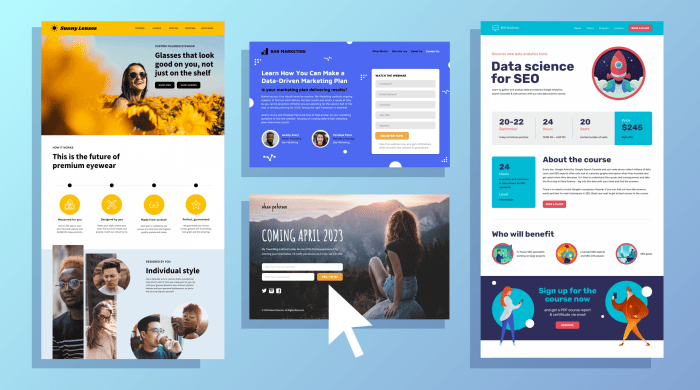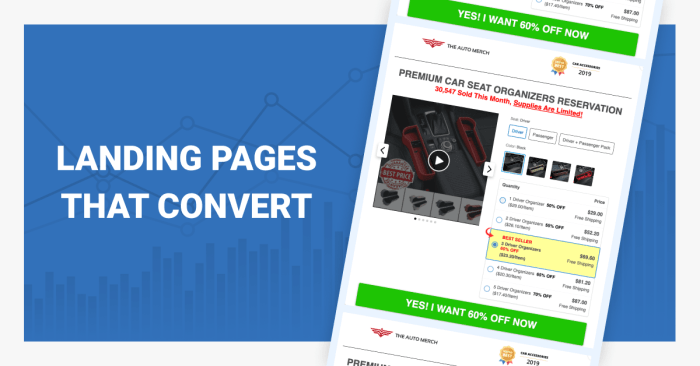Creating Landing Pages That Convert sets the stage for skyrocketing success in the digital realm, unveiling the secrets to crafting captivating pages that drive results. Dive into this journey of design and persuasion, where every element plays a crucial role in turning visitors into loyal customers.
Understanding the purpose of landing pages, designing visually appealing layouts, crafting compelling copy, and optimizing for conversions are just a few steps on the path to a high-converting landing page.
Understanding Landing Pages
A landing page is a single web page specifically designed to capture a visitor’s attention and prompt them to take a specific action, such as signing up for a newsletter, downloading a resource, or making a purchase.Landing pages are crucial for conversions because they serve as the entry point for potential customers into your sales funnel. By focusing on a single call-to-action and removing distractions, landing pages can increase the likelihood of visitors completing the desired action.
Key Elements of an Effective Landing Page
- Clear and Compelling Headline: The headline should clearly communicate the value proposition and encourage visitors to continue reading.
- Strong Call-to-Action: A prominent and action-oriented button or form that directs visitors to take the desired action.
- Engaging Visuals: Use images or videos that support the message and capture the visitor’s attention.
- Concise Copy: Keep the text on the landing page clear, concise, and focused on the benefits of taking action.
- Social Proof: Including testimonials, reviews, or trust badges can help build credibility and trust with visitors.
- Mobile Responsiveness: Ensure the landing page is optimized for mobile devices to provide a seamless user experience.
Designing a High-Converting Landing Page

Creating a visually appealing layout is crucial when designing a landing page that converts. The layout should be clean, user-friendly, and visually engaging to grab the attention of visitors and keep them interested in exploring further.
Tips for Creating a Visually Appealing Layout
- Use white space effectively to avoid clutter and make important elements stand out.
- Choose a visually appealing color scheme that aligns with your brand and creates a cohesive look.
- Ensure the layout is responsive and optimized for mobile devices to provide a seamless user experience.
- Incorporate high-quality images and graphics that enhance the overall design and communicate your message effectively.
The Importance of Clear Call-to-Action Buttons
Having clear and compelling call-to-action buttons is essential for guiding visitors towards the desired action on your landing page. Make sure the buttons are prominently displayed, use action-oriented language, and stand out visually to encourage clicks.
The Role of Color Schemes and Imagery in Landing Page Design
Using the right color schemes can evoke emotions, create visual hierarchy, and reinforce your brand identity. Choose colors that complement each other and align with your brand personality. Additionally, incorporating relevant imagery can help communicate your message, capture attention, and make your landing page more visually appealing and memorable.
Crafting Compelling Copy: Creating Landing Pages That Convert

Crafting compelling copy is essential when it comes to creating landing pages that convert. Your copy should grab the reader’s attention, engage them, and ultimately drive them to take action. One of the key elements of compelling copy is the headline.
Writing Persuasive Headlines
When writing headlines for your landing page, make sure they are clear, concise, and compelling. Your headline should communicate the main benefit or value proposition of your offer in a way that resonates with your target audience. Use action-oriented language and create a sense of urgency to encourage visitors to continue reading.
- Keep it short and sweet: Aim for around 6-12 words to ensure your headline is easily digestible.
- Highlight the main benefit: Clearly communicate what the visitor will gain from your offer.
- Use power words: Words like “free,” “new,” “exclusive,” and “limited time” can help capture attention.
- Create urgency: Encourage immediate action by using phrases like “Act Now” or “Limited Time Offer.”
Importance of Engaging and Concise Content
In addition to a strong headline, the rest of your copy should be engaging and to the point. Avoid using jargon or unnecessary technical language that could confuse or turn off visitors. Your content should be easy to understand and highlight the key benefits of your offer.
- Focus on benefits, not features: Explain how your offer will solve a problem or improve the visitor’s life.
- Use storytelling: Create a narrative that connects with your audience on an emotional level.
- Break up text: Use bullet points, subheadings, and short paragraphs to make your copy easy to scan.
- Include a clear call to action: Tell visitors what you want them to do next, whether it’s signing up for a free trial or making a purchase.
Tips for Creating Compelling Copy
Crafting copy that drives conversions requires a deep understanding of your target audience and what motivates them. Here are some tips to help you create compelling copy for your landing page:
- Know your audience: Tailor your copy to speak directly to the needs and desires of your target market.
- Use social proof: Include testimonials, reviews, or case studies to build credibility and trust with visitors.
- A/B test your copy: Experiment with different headlines, calls to action, and content to see what resonates best with your audience.
- Focus on benefits: Clearly communicate the value of your offer and how it will improve the lives of your customers.
Optimizing for Conversions
To maximize conversions on your landing page, it’s crucial to continuously test and optimize various elements. A/B testing is a powerful technique that allows you to compare two versions of a page to see which one performs better. By testing elements like headlines, images, call-to-action buttons, and overall layout, you can make data-driven decisions to improve conversion rates.
A/B Testing for Optimization
- Test one element at a time: To accurately determine the impact of changes, only test one element at a time.
- Set clear goals: Define specific goals for each test to measure success accurately.
- Analyze results: Monitor and analyze the data to understand which version is driving more conversions.
- Iterate and repeat: Use the insights gained from each test to make iterative improvements and continue optimizing.
Importance of Responsive Design, Creating Landing Pages That Convert
With the increasing use of mobile devices, having a responsive design is essential for optimizing conversions. A responsive landing page adjusts its layout and content to fit different screen sizes, providing a seamless user experience across devices.
Optimizing Loading Speed
Slow loading speed can significantly impact conversions, as users tend to abandon pages that take too long to load. To optimize loading speed:
- Optimize images and videos: Compress images and videos to reduce file sizes without compromising quality.
- Minimize HTTP requests: Reduce the number of elements that require separate server requests to load.
- Enable browser caching: Utilize caching to store frequently accessed resources locally, reducing loading time for returning visitors.
- Use a content delivery network (CDN): Distribute content across multiple servers geographically to deliver faster loading times globally.